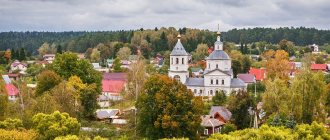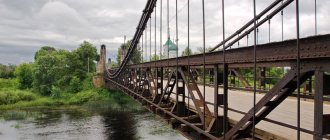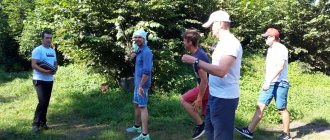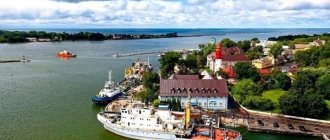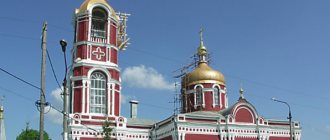Volokolamsk is a small city northwest of Moscow. Mentioned in the Laurentian Chronicle under the name Volok na Lama in 1135, it became an important point on the trade route from Novgorod to the lands of Moscow and Ryazan.
Being the most ancient city in the Moscow region, Volokolamsk often experienced a change of rulers: the Novgorod, Moscow, Vladimir, and Smolensk princes ruled it until the Lithuanian invasion, which, by the way, was successfully repelled by Volokolamsk.
Sadly, the city was also subject to destruction: in the 13th century it was captured by Khan Batu and Khan Duden; Volokolamsk suffered greatly during the Second World War, repelling the enemy’s attack on Moscow.
Today Volokolamsk is famous for its clean air, beautiful nature along the banks of the Gorodna River, a tributary of the Lama, and the ethno-festivals taking place there.
On the way to Volokolamsk from Moscow you will pass the Arkhangelskoye estate, the Vadim Zadorozhny Museum of Technology, the New Jerusalem Monastery and other interesting sights - look at them on the map of important places in the Moscow region.
What to see in Volokolamsk on your own?
Interesting places and main attractions of the city and its surroundings: photos with descriptions, tips on where to go, where to go by car, what to see in one day.
Church of the Vladimir Icon of the Mother of God
In a small village, near Volokolamsk, there is a wonderful church built according to Bazhenov’s design. The church building is a perfectly preserved example of neo-Gothic architecture.
At first glance, the church looks like a castle with beautiful turrets, domes and stairs to the second floor. Despite the fact that most of the churches were closed during Soviet rule, the Church of the Vladimir Icon of the Mother of God continued to function, services were held regularly, regardless of the government ban.
Its decoration has been preserved in its original form, so in modern times it is not only a religious site, but also an important part of the architectural heritage.
Memorial to the Panfilov Heroes
The Memorial to the Panfilov Heroes was erected in 1975, in honor of the thirtieth anniversary of the victory in the Great Patriotic War. The monument has an impressive size - more than 10 meters.
Although the memorial complex is dedicated to 28 soldiers of the Red Army from the rifle division of Major General I.V. Panfilov, it is represented by 6 figures. Because these are symbolic images. They represent the 6 nationalities of the battalion’s warriors.
This monument is a thank you to all those who defended their Motherland and did not return from the battlefields. In such places you understand what people were ready to do to provide a bright future for their children.
Yaropoletskaya HPP
The Yaropoletskaya hydroelectric power station attracts tourists with its charm, beautiful wildlife and interesting history. Despite the fact that access is officially closed to outsiders and excursions are not conducted, there is a watchman at the station who will happily show everyone the territory of the hydroelectric power station, tell interesting facts and show photographs.
Yaropoletskaya HPP is one of the first hydroelectric power plants built on the territory of the Russian Federation. The opening of the station was timed to coincide with the visit of Lenin and his wife to Yaropolets. Photo sessions are often held on the territory; even newlyweds come. In the summer, it can be crowded, many come to sunbathe, swim, surrounded by the old station.
Stella Volokolamsk - the city of military glory
The stela “Volokolamsk - the city of military glory” is a very important monument for residents and guests of the city. The title of the city of military glory was awarded to Volokolamsk in 2010, after which a stele appeared in the city. The sign says that the entire history of our city, the most ancient city in the Moscow region, is inextricably linked with military valor and courage.
Volokolamsk Kremlin museum and exhibition complex
The Volokolamsk Kremlin, which is located on the city rampart, is considered a unique architectural monument of Volokolamsk. The museum's exposition presents the history of the Moscow region, starting from the fourth century BC. Of great interest is the fragment dedicated to the period of the city’s creation, starting in 1135.
Many are attracted by exhibits representing the history of the emergence of the Joseph-Volotsky Monastery and the life of St. Joseph of Volotsky. According to the preserved data, the fortress existed since the formation of the city. The Resurrection Cathedral and earthen ramparts have survived to this day, from which a beautiful view of the city’s panorama opens.
Resurrection Cathedral
An excellent representative of medieval Russian temple architecture, located in Volokolamsk, is the ancient Resurrection Cathedral. It is considered an architectural monument of the early Moscow period of the 15th century. The temple looks like a strict white stone building of a square shape, which is crowned with a helmet-like dome.
Although the church has been rebuilt several times, the main architectural features are still preserved. Only the ancient paintings made in the 15th century have not survived. Most of the frescoes on display are from the 19th century. Adjacent to the temple is St. Nicholas Cathedral and bell towers, which form an incredible ensemble of ancient architecture.
Panfilov Heroes Museum
In the small village of Nelidovo, Volokolamsk district, there is an interesting museum of Panfilov heroes, telling about the exploits of the soldiers and commanders of the Panfilov division. The first hall of the museum includes an exhibition with portraits of Heroes of the Soviet Union, participants in the battle at the Dubosekovo crossing.
In the museum you can also see important documents, personal letters, weapons, and belongings of heroes. Unique exhibits that attract many tourists are a magnifying glass and a curvimeter, which belonged to General I.V. Panfilov, as well as personal belongings of division veterans.
Near the village, a memorial was also opened in 1975, consisting of six figures, ten meters high, holding machine guns and grenades in their hands. Not far from the memorial there is a mass grave of Panfilov heroes.
Estates of the Goncharovs and Chernyshevs
A beautiful estate that has survived to this day in Volokolamsk, which is considered a local architectural monument, is the estate of the Goncharovs and Chernyshevs. A.S. Pushkin rested in the estate more than once, because it was here that his mother-in-law was born, and the poet’s future wife often spent the summer.
In the post-revolutionary period, the owner of the estate opened a zemstvo school here and achieved recognition of the estate as a cultural monument. In 1960, the estate was transferred to the Moscow Aviation Institute as a holiday home. It was restored and returned to its original appearance.
The entrance to the estate, today, is open only to guests of the sanatorium, but anyone can walk around the adjacent territory and examine the estate from the outside.
Church of the Nativity
Not far from the center, as you climb the city hill, there is the ancient Church of the Nativity. It was built in 1653, in the form of a small wooden structure, on land belonging to the St. Sergius Church destroyed during the war.
During the 18th century, the wooden church burned down several times, so it was decided to build a two-altar stone church. The building was completed in 1778. The temple, preserved to this day, although in need of reconstruction, is the greatest architectural monument.
The antiques have been preserved inside: paintings, frescoes and tiles. You can hear excellent acoustics, which have been preserved due to the shape of the building.
St. Nicholas Cathedral
In the second half of the 19th century, St. Nicholas Cathedral was built in Volokolamsk. The cathedral is considered a monument dedicated to all those who died during the Crimean War. The walls of the cathedral are decorated with the remains of paintings from the early 20th century. The facade of the cathedral is built of red brick, which is decorated with white stones and plastered bricks.
St. Nicholas Cathedral is located not far from the Church of the Resurrection, and balances it with its proportions and size. The basis of St. Nicholas Cathedral is a quadrangle with windows framed by carved platbands.
Nowadays, the premises of the cathedral are given over to the exhibition of the Volokolamsk Historical and Architectural Museum. Anyone can visit the museum to not only see the exhibition, but also enjoy the architecture.
Yaropoletsk People's Museum of Local Lore
Located in Yaropoletsk, the local history museum is small, but very cozy. The museum's exposition is presented in the form of five sections, which are dedicated to the electrification of the Yaropolets volost, the history of the fate of Pushkin and the Goncharov family, as well as Chernyshev and the Decembrists.
In the museum you will learn the history of the Yaropolets region and the historical figures who lived here. Pleasant and helpful staff will tell you about what you need to pay attention to in the ruins of the Kazan Church, what Pushkin wrote in letters addressed to his wife, and how Lenin and Krupskaya came here.
In one of the museum’s expositions there is a table at which the creator of the Soviet state sat in the Yaropolets People’s House; the tablecloth on the table has also been preserved from that day.
Church of the Kazan Mother of God
The Church of the Kazan Mother of God is known for the fact that its construction took more than 50 years. The idea of creating a combined building of a church and a tomb belonged to Count Chernyshev, and gave rise to a composition unusual for Russian architecture. Construction began in 1780, but due to the death of Chernyshev, it was delayed and was completed only at the beginning of the 19th century.
The project itself was created by the famous architect of the 18th century, M. F. Kazakov. The temple looks like a stone, plastered structure, decorated with stucco white stone trim. The architectural style is also classified as classicism. Divine services were held in the temple until 1962, after which it was closed, and the premises were given over to a flax storage facility.
Today, the temple is closed, but you can get inside without much difficulty, because it is not guarded or fenced off from the townspeople.
Ostashevo Estate
The Ostashevo estate, located in the settlement of the same name, has a fascinating history and interesting fate. Despite the fact that it is almost completely destroyed, the estate deserves attention from tourists. The estate appeared in 1790, the owner was Prince Alexander Urusov, but he did not own it for long.
In 1804, the property passed to the founder of the Moscow School of Column Leaders, Nikolai Muravyov. From this period the interesting chronicle of the Ostashevo estate began. At this time, the summer practice of future officers of the General Staff took place in the estate, many of them became Decembrists.
Now the estate attracts with the beauty of the ruins and the preserved atmosphere, which is conveyed to every visitor. Many tourists come here for beautiful photo sessions.
Trinity Church
In the right bank part of the city of Volokolamsk, the Trinity Church is located. This brick structure was erected on the site of the wooden church of St. Elijah, which existed at the end of the 17th century. After the destruction of the temple of St. Elijah, local merchants decided to build a new wooden temple in the name of the Life-Giving Trinity.
It served until the end of the 18th century, when a decision was made to build a new three-altar stone church. It was erected with the funds of a famous Moscow merchant, Alexei Ivanovich Kushashnikov.
Construction was completed by 1804, the temple was immediately consecrated and services began to be held, which continue to this day. Anyone can visit the temple; there are no restrictions.
Ostashevo Museum of Local Lore
In the small village of Ostyshevo, which is located next to Volokolamsk, there is a very interesting Ostashevo Museum of Local Lore. It tells visitors the history of this region, showing historical documents and old photographs that have survived to this day.
Among the exhibits you can also see various peasant household items from the late 19th – early 20th centuries. The museum even has a children's exhibition, presenting various toys and a highchair that came to the museum from a nursery that was organized by Konstantin Romanov.
The toys housed in the museum were produced at the Ostashevsky factory. For history buffs, there is a separate room with a military theme that reveals various historical aspects.
Ruins of the Church of St. Nicholas the Wonderworker
The Church of St. Nicholas the Wonderworker was built in 1888; only the ruins of this Orthodox church in the Likhachevo tract have survived to this day. The temple was built on the site that had previously been occupied by a wooden church. The Cathedral of St. Nicholas the Wonderworker has two boundaries, one of which is dedicated to the prophet Elijah, and the second to the Kazan Icon of the Mother of God.
The architect of the temple is I. Baryutin. He created a temple in the pseudo-Russian style, which included a tented bell tower and a spacious refectory. The place where the temple was built was considered unclean. Therefore, it was decided to build a temple, which was supposed to “cleanse” the area.
But the temple did not last long; in the 30s of the 20th century it was partially destroyed and closed, and the ruins have survived to this day.
Estate "Ivanovskoye-Bezobrazovo"
One of the most famous estates of the Bezobrazov family, whose descendants include many statesmen, is the Ivanovskoye-Bezobrazovo estate. It was owned by the Bezobrazov family from the mid-18th century until 1917. The architectural style to which the estate belongs is classicist, which is complemented by decorative features of false Gothic.
The composition of the estate cannot be called original, but its unique beauty attracts many tourists. Most of the buildings, both residential and service, are oriented towards the access road. The well-being of the estate is evidenced by the church with bell towers and the surrounding, well-kept park with a small pond.
Although the estate is now dilapidated, one can appreciate its architectural style and historical value.
Zoo nursery in Sychevo
Not far from Volokolamsk, in the small village of Sychevo, a zoo nursery of the Moscow Zoo was opened. The nursery was created with one important mission: to preserve rare, endangered species of animals. It is located on an area of about 200 hectares and has existed for several decades, starting in 1994.
The territory of the nursery has become home to such rare animals as polar bears, red wolves, wolverines, camels and many others. Many feathered representatives also live here (mallards, bustards, golden eagles, vultures and others).
The total number of inhabitants reaches a thousand individuals, which are representatives of 200 species of rare animals. Tours are conducted on site in small groups so as not to disturb the animals.
Joseph-Volokolamsk Monastery
The monastery, founded in 1479 by St. Joseph, still operates today as an Orthodox monastery for men. In the 16th century it became very popular among people of different classes as a place of pilgrimage. After the revolution of 1922, the monastery was temporarily closed, and all the valuables belonging to it were transferred to museums in Moscow.
The territory of the monastery itself was given over to open an orphanage, a school and a cinema hall. During the Great Patriotic War, the buildings on the monastery territory were partially destroyed, and after the war they were restored and the territory was returned to the believers.
There are many burial places of Russian princes and church hierarchs here. The main shrine of the monastery is considered to be the relics of its founder, St. Joseph of Volotsky.
Peter and Paul Temple
On the territory of Volokolamsk, until 2014, there were three operating churches, which were joined by a fourth - Petropavlovskaya. The temple has an interesting history, which began in 1695, the year the construction of the building was completed.
The building was constantly subject to destruction, the largest of which occurred in the 30s of the 20th century. Then the church was destroyed both outside and inside, valuables were stolen. Since then the temple has been closed and neglected. The building was not restored, the area was not cleaned.
In 2008, it was given over to a private enterprise. But in 2014 the decision changed, the Peter and Paul Church was recognized as a cultural and architectural monument and returned to the church. After which restoration was carried out, the building was returned to its former appearance, which was captured in the photo in 1917. Now the church regularly holds services.
Source
Where to go with children in Shchelkovo
Shchelkovo will offer a wonderful cultural and educational program for the young traveler. There are several wonderful places in the town and its surroundings where children will have a lot of fun.
Cosmonaut Training Museum
Both the child and his parents should visit this amazing place. The collection of the museum, created at the Cosmonaut Training Center in the world-famous Star City, consists of rare exhibits and real relics. A separate exhibition hall is dedicated to the first earthling to be in low-Earth orbit. Personal belongings, archival and photographic documents telling about the life path of Yuri Gagarin are displayed here. Visitors will be able to see the simulators on which interstellar space researchers prepare for their missions, and listen to an interesting lecture on the history of space exploration. Museum guests are also invited to visit the Planetarium and Hydrological Laboratory.
Shchelkovsky Park of Culture and Leisure
The city park occupies an extensive recreation area stretching along the picturesque bank of the Klyazma River. Here you can have a wonderful time with the whole family. Teenagers enjoy riding bicycles, scooters, and rollerblades along the shady alleys. For children there is a special playground with trampolines, inflatable towns, and carousels. Experienced animators work with young visitors. Teenagers will certainly be interested in attractions of varying degrees of extremeness. Guests of the city are always welcome to visit the cafe, where delicious desserts are offered to those with a sweet tooth, big and small.
Museum of Military Uniforms
The fact that this wonderful museum is located on the territory of an active military unit is very symbolic
The quartermaster service has always been an important component of the Russian army. Not a single boy will refuse to view the unique exposition of the institution.
From the exhibits on display here, it is easy to trace in retrospect how military fashion has evolved - from the uniforms of Peter the Great's grenadiers to the equipment of modern special forces.
You can come to the colorful town on purpose or combine its visit with a tour to Moscow. There is certainly something to see here. The sights of Shchelkovo will not disappoint even the most experienced traveler.
We are going to Volokolamsk: the ancient Kremlin, monuments and many churches
Today Volokolamsk is a quiet regional center near Moscow, but in the past it was at the center of a variety of historical vicissitudes. Once upon a time, the city became a bone of contention between the Novgorod Republic and the Moscow Principality. Volokolamsk was briefly ruled by the Grand Duchy of Lithuania; it was besieged by the princes of Tver and the troops of the Polish-Lithuanian Commonwealth. He even visited an independent appanage principality.
The reason for such close attention of the feudal lords to the small town is explained by its name - Volok Lamsky. Here they transported (“dragged”) ships from the Lama River (a tributary of the Shosha, which flows into the Volga) to Voloshnya (a tributary of the Ruza, which flows into the Moscow River). It was an important outpost on the trade route from Novgorod to Moscow.
Its turbulent history has contributed to the appearance of architectural monuments in the city, for which it is worth visiting. You can come to Volokolamsk for one daylight and see it, Yaropolets, Dubosekovo and the Joseph-Volotsky Monastery.
Moscow Raceway
What Russian doesn't like driving fast? Remembering this rhetorical question from the work of Nikolai Vasilyevich Gogol, you can visit the sports and entertainment center in the village of Sheludkovo . Car and motorcycle races are regularly held here, as well as track days, when even a beginner can try his hand at the race track.
Photo: https://ru.wikipedia.org
Volokolamsk Kremlin and temples
First of all, go to the city Kremlin. Here the history of Volokolamsk is not just visual - it can be touched. Today, Kremlins in ancient cities are museum complexes and administrative centers, but initially they were fortresses, a stronghold of defense in wars in the 12th–17th centuries. The architecture of such structures is subordinated to one goal: to make a siege difficult and an assault almost impossible. Therefore, to get to the Volokolamsk Kremlin, you will have to overcome the slope of a high hill. The earthen rampart delineating the boundaries of the ancient fortress was erected from the 11th to the 17th centuries. Gorval Street, on which the Kremlin is located, is called that way precisely because of it.
The museum territory of the Kremlin is surrounded by a wall with four towers at the corners. Of course, these are not original fortifications, but an important monument of the late 19th - early 20th centuries, when Russian cities became interested in their own antiquities. The monuments were supplemented with lost details in the architectural taste of that time.
Resurrection Cathedral
The Resurrection Cathedral is the most interesting of the surviving buildings of the Kremlin. This is a monument of early Moscow architecture of the 15th century. The buildings of that era that have survived in Moscow and the Moscow region can be literally counted on one hand. The cathedral was founded around 1480, when Volokolamsk was the capital of an appanage principality and it needed a large stone church in the very heart of the city. The cathedral was rebuilt several times. However, the concept of “architectural monument” will spread only in the 19th century. Pay attention to the graceful portals and decorative belts.
The cathedral's five-tier bell tower was erected in the 1880s by architect Markov. You can and should climb it. A full range of impressions awaits you from the tall ancient buildings: a narrow spiral staircase, the opportunity to see the bells up close and a beautiful view of the picturesque center of the county town, unspoiled by the high-rise construction of recent decades, the Gorodnya River and the hills around. A ticket inside costs 200 rubles for adults and 100 rubles for children. Due to coronavirus restrictions, in the summer of 2022, no more than five people were allowed into the bell tower at a time.
Alley of Love
This miracle is located on one of the shores of School Lake. In 2009, a hand-forged Love Tree was erected on the alley. According to the newly introduced traditions, immediately after painting, the newlyweds hang locks with their names on it, and the keys from them are thrown away not just anywhere, but directly into School Lake.
This is a symbol not only of the strong family relationships of the young spouses, but also a testament to their strong mutual love and strong friendship. There are a large number of benches and gazebos, and there is even a special sports ground and stage. On weekends and holidays, all kinds of concerts are held on the Alley of Love.
St. Nicholas Cathedral
Next to the Resurrection Cathedral there is another temple named in honor of St. Nicholas the Wonderworker. It was built in the mid-19th century in memory of those killed in the Crimean War, but it looks more ancient than its neighbor. Architect Konstantin Andreevich Ton clearly tried to stylize his building as a temple of pre-Petrine Rus'. He himself defined his architectural style as “Russian-Byzantine”. The architect also worked on the Moscow Cathedral of Christ the Savior and the Grand Kremlin Palace.
Since Soviet times, the cathedral building has housed a large museum of the history and ethnography of Volokolamsk and the surrounding area. The exhibition (archeology, objects from the surrounding noble estates, the years of the Great Patriotic War, etc.) occupies two floors. Pay attention to the impressive size model of the wooden Volokolamsk Kremlin. An adult ticket costs 200 rubles, a child ticket costs 100 rubles.
Volokolamsk Kremlin Address: Volokolamsk, st. Gorval, 1 Website: volok-kreml.ru
After visiting the Kremlin, you can sit on the earthen rampart near the inscription “Volokolamsk 1135” (the city was first mentioned in chronicles 12 years earlier than Moscow), look at the monuments to the heroes of the Great Patriotic War on Oktyabrskaya Square and stroll along Revolyutsionnaya Street, landscaped in the summer of 2022. You can also have lunch, since we are moving further outside the city.
Memorial to Volokolamsk residents who died during the Great Patriotic War in the Moscow region Address: Volokolamsk, pl. Oktyabrskaya
House-Museum of A.P. Gaidar
At the end of the last century, the house-museum of the writer Gaidar was opened in the city. This historical monument contains his photographs, books, things and household items associated with his creative nature.
The museum exposition introduces tourists to his work, written in this city; there is a video screening of famous literary works, such as: “Chuk and Gek”, “The Tale of the Kibalchish Boy”, “Timur and His Team”, etc.
For children, events are offered related to the writer’s favorite childhood holidays, gatherings and trips to Gaidar’s country, and you can also celebrate the New Year there with Chuk and Gek.
The museum hosts various outdoor activities. Theater programs, games, songs and round dances.
Address: Gaidar street-17.
Memorial to the Panfilov heroes in Dubosekovo
In the village of Dubosekovo, neighboring Volokolamsk, there is a memorial to the Panfilov heroes: six figures of warriors 10 meters high. The sculptural group was opened on the 30th anniversary of the Victory in 1975. The memorial can be seen out of the corner of your eye from the train at Dubosekovo station, but it is better to take time for a detailed inspection in order to appreciate the scale of the complex. If you are traveling to Volokolamsk by train, you can first get off at Dubosekovo and examine the memorial. It stands literally a stone's throw from the station, and Dubosekovo station is the penultimate stop before Volokolamsk. Then you can go to the city by taxi or bus No. 42, it runs several times a day.
Memorial to the Panfilov heroes Address: Moscow region, pos. Dubosekovo
Monument to the bus worker
Near the bus depot on Lenin Street you can see a LIAZ-677 preserved in excellent condition, which for many years transported passengers in Volokolamsk. A great place to take original photos and indulge in nostalgia about the Soviet era.
Photo: https://www.drive2.com
Estate Ivanovskoye-Bezobrazovo
On the northern outskirts of Volokolamsk, the Bezobrazov estate of the late 18th century is living out its days. The buildings of the former estate are currently in a state of disrepair, close to ruins. At the same time, the manor church of the Icon of the Mother of God “The Sign” was recently reconstructed, preserving the iconographic decoration. On the territory of the church there are burial places of members of the Bezobrazov family, one of the most famous representatives of which was Alexander Mikhailovich Bezobrazov, state councilor, one of the ideologists of the Russo-Japanese War.
Estate Ivanovskoye-Bezobrazovo Address: Moscow region, p. Ivanovskoe
Yaropolets
There are few villages with such a long and rich history as Yaropolets. It was first mentioned in chronicles in the 12th century, simultaneously with Volokolamsk itself. In the 18th–19th centuries, two large noble estates were located here. They are what interests us.
You can get from Volokolamsk to Yaropolets by bus No. 28, it goes from the “Gorod” stop at the foot of the hill on which the Kremlin stands. The journey will take 30–40 minutes, but you will also have to walk several kilometers through the village itself. It will be faster by your own car or taxi and you can get to all interesting places at once.
Goncharovs' estate
At the end of the 17th century, the village of Yaropolets, by decree of Princess Sophia, was transferred to the retired hetman of the Zaporizhian Army Petro Doroshenko, who lived here for 14 years until his death. As a dowry, the estate went to Lieutenant General Alexander Zagryazhsky, who rebuilt the wooden buildings of the estate in stone. His granddaughter Natalya Zagryazhskaya married Nikolai Goncharov, and from this marriage Natalya Goncharova was born, Pushkin’s wife, known to us from school. Alexander Sergeevich came to this estate twice to visit his mother-in-law, who gave him library books, jam and homemade liqueurs.
The manor's house with outbuildings, completely rebuilt by Zagryazhsky in the 1780–1790s, is a good example of classicism: ideal proportions of columned porticos with triangular pediments on top, symmetry. The ceremonial ensemble is completed by circumferences - arched buildings with small turrets, where the carriage house and stables were located. But the most interesting building of the estate from an architectural point of view is the Church of John the Baptist, rebuilt with the addition of boundaries in 1808. This is a rare example for Russia of architecture at the intersection of late classicism and early Empire style, embodied even before the end of the Napoleonic wars. The decor is very similar to that of a manor house, but more laconic and austere. You won’t see the usual church dome here: the dome of the church is crowned with a gilded ball with a cross.
The temple fence is decorated with gates with decorative round turrets decorated with battlements, like on the walls of the Moscow Kremlin. This is how ancient architecture was imitated in the 18th–19th centuries.
The estate was almost destroyed during the Great Patriotic War. In the 1960s, it was restored and given over to the MAI holiday home, which is still located there today. Unfortunately, only guests of the sanatorium can enter the territory. Getting to the church is much easier: you need to be here during the service or when one of the temple servants is inside. Everyone is allowed in provided they behave politely and calmly.
Chernyshev Estate
The Chernyshev estate located next door is in a much more deplorable state. It burned down during the Great Patriotic War, and since then a full restoration has not been carried out. The territory is fenced, and you can only look at the remains of the estate from behind the fence.
The estate was founded in 1717, when the Chernyshev count family bought part of the estate lands from their neighbors. One of the representatives of the family was the Moscow governor-general; Catherine II visited the estate. Until the revolution, a rich collection of maps, paintings, books, and sculptures was preserved here. All this was received in the 1920s by the regional museum of local lore, which was created in the New Jerusalem Monastery.
If you look at the estate from Pushkinskaya Street, then to the right of the fence there will be a path leading to the estate park between the buildings and the bank of the Lama River. The park is very overgrown and has lost its former splendor, but it makes sense to walk to the preserved granite stele, installed in honor of the visit of Catherine II. By the way, there is a similar stele in Kuskovo, now located on the outskirts of Moscow. Just be careful and watch your step.
The most interesting architectural part of the complex, as in the Goncharov estate, is the temple. The Church of the Kazan Icon of the Mother of God, unfortunately, also did not experience large-scale restoration. As is the case with many Moscow and Moscow region buildings of the 1780s, the name of the architect has not been precisely established.
The layout of the temple is unique for Russian architecture: the building is elongated in width, the distance between the main entrance and the altar is much less than the diameter. It seems as if two ordinary churches were connected by side facades. The answer to the unusual layout is that one part of the building was intended for a summer, cold church, and the second housed the Chernyshev family tomb and a warm, winter church. The triangular pediment above the main entrance depicts the All-Seeing Eye - one of the symbols of Masonic organizations of that era (however, it could simply be a symbol of enlightenment).
The temple is still in operation, but there are not yet sufficient funds for its restoration. Scaffolding and other signs of renovation work can be seen on the façade.
Museum of German Anti-Fascists
According to historical data, in May 1942, camp No. 27 for prisoners of war was built in the city of Krasnogorsk. More than 50 thousand German prisoners of war passed through it. The status of this premises was quite high, to such an extent that its head was appointed by the People's Commissar of Internal Affairs himself. This camp existed until 1950.
In 1985, the leadership of the GDR proposed to create a Memorial Museum of German Anti-Fascists in its place, which was brought to life.
Location: street.
In the vicinity of the city of Dedovsk there are many more attractions, natural and historical monuments, beautiful architectural buildings and much more. It’s better to see everything with your own eyes once than to read about it thousands of times. And the presence of a large number of hostels and hotel complexes will give tourists the opportunity to comfortably stay in the city.
Yaropoletskaya HPP named after V.I. Lenin
Behind the Chernyshev estate there is an extremely interesting object of the Soviet era: the first rural hydroelectric power station in Russia - it is not without reason that all nine centuries of the village’s history are connected with the Lama River.
The first years of Soviet Russia were a time of severe energy crisis: there was not enough fuel to operate steam engines and internal combustion engines. The way out of this situation was electrification. In 1921, the most ambitious infrastructure plan of the era was adopted - GOELRO (State Electrification of Russia). Lenin then directly said that “communism is Soviet power plus the electrification of the entire country.” Yaropolets was at the forefront of the project.
In 1919, village residents, on their own initiative, rebuilt the water mill on Lama into a small hydroelectric power station: they connected a current generator to the mill wheel, which gave them a source of almost free energy. In 1920, Lenin and Krupskaya came to inspect the hydroelectric power station. With the approval of senior management, the makeshift power plant was rebuilt into a completely serious structure that supplied electricity to 22 villages. In 1941, German troops blew up the station, but after the war the historical building was restored.
What can you see here today? The restored building of the turbine hall of the first hydroelectric power station, a small wooden building with a generator and other equipment inside, a water canal and the first turbine nearby. You can get to these buildings via a reinforced concrete bridge over an elegant semicircular dam, through the spillway of which river water flows very beautifully.
Yaropoletskaya HPP Address: Moscow region, p. Yaropolets
Joseph-Volokolamsk Monastery
From Yaropolets you can go to the Joseph-Volotsky Monastery. To do this, you will have to return to the stop where you arrived from Volokolamsk, wait for the same bus No. 28, take it to the village of Maslennikovo, there change to bus No. 31 and go to the Valuyki stop, from which you have to walk another 15 minutes . By car the journey will take about half an hour.
Like the Resurrection Cathedral in Volokolamsk, the monastery is a legacy of the appanage principality that existed on these lands at the end of the 15th century. It was founded in 1479 by St. Joseph (hence the name). Despite all the vicissitudes of Russian history, the War of 1812, the revolution and the German occupation, the architectural ensemble of the 16th–17th centuries has been preserved almost completely.
The territory of the monastery is surrounded by walls with six towers built in the 1670s–1680s. The center of the ensemble is formed by two impressive buildings, demonstrating the development of Russian architecture over two centuries. The first of them is the Church of the Epiphany with a refectory, built at the beginning of the 16th century, 20 years before the birth of Ivan the Terrible. Here we see the gradually emerging distinctive architectural tradition of Russia: a pile of kokoshniks under five narrow domes, small windows located on the facades without a clear rhythm. The decor on the walls is still extremely poor.
And literally a few steps away is the Assumption Cathedral, built at the end of ancient Russian architecture, at the end of the 17th century. Architect Kondraty Mymrin created an almost cubic building with richly decorated facades, on a powerful basement, surrounded on three sides by open galleries. Be sure to go inside if the cathedral is open and admire an exemplary example of the painting of Orthodox churches of the 16th–17th centuries.
Nearby you can see ruins covered with a canopy: these are the remains of a bell tower from the 1510s. There was another temple in the lower tier of the bell tower. Over time, the structure gradually tilted like the Leaning Tower of Pisa. Unfortunately, in 1941 it was destroyed by an explosion.
If you have time and energy left, go to the Museum of the Bible, the first such museum opened in Russia. The most interesting works of book art from the 16th–19th centuries are presented there, in particular the Ostrog Bible of 1581. Technologies for making books in this era, their artistic design, features of handwriting and typographic fonts are an interesting topic that is worth getting acquainted with.
You can sign up for a tour of the monastery and buy tickets to the museum from the monastery security staff at the entrance. There is a small refectory on site where you can have a fairly affordable snack of tea or coffee and a pie. Visiting the territory and temples is free; photography is not allowed inside the Assumption Cathedral; the clothing requirements for visitors are standard for Orthodox monasteries.
Joseph-Volotsky Monastery is located in a very picturesque place, surrounded by forest and water. You can walk around the monastery from the outside, sit by the cross-shaped font on the shore of the pond.
Joseph-Volotsky Monastery Address: Moscow region, village. Teryaevo Website: https://iosif-vm.ru/
Ostashevo Estate
The estate in the village of Ostashevo is located in the south of Volokolamsk, away from all other places from the guide. But it was there that a magnificent equestrian yard with a tower in the style of Flemish churches was preserved. Now there is a museum in the estate; the estate itself is interesting because the Decembrists gathered here, the owners at that time were the Muravyovs.
Ostashevo Estate Address: Moscow region, Ostashevo village Website: museum.ru
Food and shopping in Volokolamsk
Not long ago, a coffee shop “History of the Place” opened in Volokolamsk, which operates an information center for tourists. Here you can learn everything about the history of the city and its attractions. There is also a souvenir shop where you can buy something to remember your trip.
Coffee house “History of the place” Address: Volokolamsk, st. Panfilova, 26b Website: visitvolokolamsk.ru
In close proximity to the Volokolamsk Kremlin, on Revolyutsionnaya Street, there is the Zotto restaurant with European and Japanese cuisine.
"Behemoth" is a family cafe with a playroom for children and an extensive bar menu for adults.
Cafe "Begemot" Address: Volokolamsk, st. Novo-Soldatskaya, 5 Website: begemot.rus
Cafe-bar Volokolamsky is located in an unobvious way even by the standards of a small town, but it has a pleasant atmosphere, cuisine and service.
Cafe-bar Volokolamsky Address: Volokolamsk, lane. Novo-Soldatsky, 8
In the City Center shopping center there is a good chain pizzeria “Lukovka”.
Pizzeria “Lukovka” Address: Volokolamsk, st. Panfilova, 22
There are two places for craft beer lovers in Volokolamsk. The first is the Dogs bar next to the bus station. The establishment nominally opens at six in the evening even on weekends, but in reality it may open later, so it is better to plan a trip there at the end of the trip.
The Drunk Family bar has no sign or geotag, but was open at the time of writing. In addition to craft and snacks, there is a hookah and billiards.
Bar Drunk Family Address: Volokolamsk, st. Panfilova, 9
Church of the Intercession
Address: st. Dovatora, 9.
Previously, the Church of the Intercession of the Blessed Virgin Mary served as the cathedral church of the Varvara Monastery, which operated in Volokolamsk. Then the old wooden building was demolished, and the young Tsar Peter I ordered the construction of a stone structure on this site, which happened in 1695. For the new building, the Old Russian style was chosen, characterized by a minimal number of decorative elements.
The institution received the status of a parish church in 1764 after the closure of the monastery. It is interesting that the Church of the Intercession was the only one of all the religious buildings in Volokolamsk that continued to operate during Soviet times.
